Materials / Raw materials
Cotton
Material
Natural fiber from the seed hairs of capsule fruits.
General information
The name cotton refers to the general origin of the fiber material as a collective term for various cotton trees or bushes such as a wool tree, kapok, and cotton.
Origin
Natural extraction of the fiber material cotton from the popping capsules of several species of the shrubby mallow family (Gossypium). Cultivation is only possible in the tropics and subtropics ("cotton belt": 35° SB to 45° NB). In addition to the extraction of the fiber material, the plants are also used to produce edible oil (seeds) and as protein-rich concentrated feed (oil cake). Cotton consists of more than 80% cellulose. In addition, water content (6%), pectinates, fats, hemicelluloses, proteins, and minerals (Σ 12%) are used as fiber accompanying substances.
Chemical composition of cellulose: As a macromolecule consisting of hundreds of thousands of atoms, cellulose, like starch, belongs to the group of polysaccharides. Through photosynthesis, thousands of glucose molecules (carbohydrates) are formed from carbon dioxide and water with sunlight and linked together via glycoside bonds. In this way, rope-like structures are formed, the long chains of (C6H10O5) monomers are bundled side by side.
Production
Cotton is cultivated on approximately 33 million hectares worldwide. For the most part "conventional" with devastating consequences for humans, animals, and the environment. In contrast, cotton from organic cultivation (*kbA, organic cotton) considers all aspects to avoid environmental pollution: from "cradle to grave", every step of the textile raw material is characterized by very high ethical and sanitary standards:
- When growing organic cotton, the usual massive use of pesticides is completely avoided
- When harvesting the cotton, preference is given to the environment-friendly (and social) manual process.
- The processing of organic cotton is done without the use of toxic-aggressive chemicals.
- After the end of its useful life, it can be introduced into the natural cycle, e.g. through composting.
Use
For 5000 years, cotton has been used to make fabrics for a wide variety of purposes. Today 75% of all textiles worldwide are made of cotton. Favorable physical properties of this natural product have recently opened up further applications as an insulating material (sound, heat).
Features
Physical: The gently treated natural material has a significantly higher tensile strength and elasticity (durability!) than, for example, mercerized goods. Due to the special processing, it is gentle and extremely soft, yet the skin-friendly material remains cleanable. Without disturbing electrostatic effects of the breathable material, the high existing potential for moisture absorption also promotes a pleasant body and sleeping climate.
Chemical: In contrast to "normal" cotton, the material is characterized
by the absence of chlorine-pesticides, DDT, lindane, and PCP. Quality tests also
show that no other pyrethroids, pesticides, herbicides, or toxic color chemicals are found!
Medical: Three properties have a direct and indirect effect on human health:
- The physical properties have a positive effect on the sleeping climate.
- The absence (of the spectrum present in conventional products) of extremely harmful chemical residues generally reduces immune stress and possible risks.
- 3. A significantly reduced germ and fungal load reduce and prevent allergenic effects, such as those caused by mold. (And: mold stains cannot develop).
All in all, the high level of lying comfort and active health care can only be achieved by holistically practiced environmental protection.
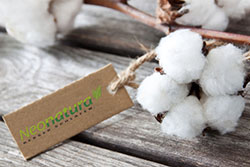
Quality features
The entire process of creating the material meets the highest ethical standards. All components, from holistic environmental protection to social effects, and health care are taken into account. Quality testing for harmful substances: Despite modern instrumental analysis technology (gas chromatography, IR-spectroscopy) none of the investigated noxious substances are detectable.
Ecology / Ethics
As it is well known, the conventional cultivation of cotton leads to considerable environmental pollution: the ground is leached out and any existing groundwater and earth are polluted with considerable amounts of toxic substances. In addition to cultivation in huge monocultures, the later conventional treatment also proves to be a toxic spinner.
Organic cotton is grown without pesticides, is organically fertilized, and meets the strict requirements of organic farming.
In addition, the renewable raw material is hand-picked. This means that the local labor market is supported and workers are not exposed to the enormous health risks of conventional field workers (who may have to accept toxic showers from airplanes) -- the average age of people working on cotton plantations is under 40 years! This is as much due to the poisoning as to the catastrophic living and nutritional conditions under which these people and their families have to live. The same applies to conventional coffee/banana/rose cultivation (to name only the most prominent). Projects that build up organic farming also pay attention to the people (most of them at least), fair wages that allow a 'dignified‘ life, and educational opportunities for the children (school until the age of 14, instead of starting fieldwork at the age of 4). Please also have a look at the page
Please see www.biothemen.de
Virgin wool
Material
Natural material of animal origin: New wool from sheep that are kept outdoors all year round - French free-range new wool ("Plein-Air")
General information
For about 7000 years sheep have been used by humans as a source of food and clothing. Other animal species, whose hair is suitable for weaving because of its length and fineness, are also used as a source of wool: Goats, rabbits, llamas, alpacas, camels, etc. The share of animal fibers in world production today is only about 5% compared to cotton and synthetic fibers.
Origin
Most importantly, our wool comes from plein-air sheep from the Portiers and Limoges area. They live outdoors almost all year round. The sheep come from the Texel and Charolais sheep breeds. Texel new wool brings good color, cleanliness and length, Charolais new wool the bulkiness. Plein Air new wool consists of pure, particularly long natural hair with very good fill power. This is favored by the optimized wool mix of different French sheep breeds as well as by the weather and the geographical location.
Chemical composition of wool
Wool (also: hair, nails, horn, feathers) is a protein and is built up from amino acids. In the case of wool, these are 18 different amino acids, whereby the sulfurous cysteine provides the natural curl of hair. Lanolin, which chemically belongs to the group of waxes, is a natural accompanying substance in wool. This substance, falsely called wool fat, is used as a by-product of wool extraction for mild and compatible ointments and (baby) creams.
Production
During live shearing, the so-called sweat or dirty wool is produced with approx. 50% impurities (sand, dust, salts, wool wax, etc.). Instead of using aggressive chemical agents, the necessary cleaning step is only done with soap. That no pesticide baths (against parasites) were applied to the sheep for breeding purposes is shown by the analysis results of the wool: without any findings.
Use
The main application of the natural material, that can be spun, is for knitwear (sweaters, scarves, socks, etc.) and carpets. Due to the special material and climate properties of the natural material, it is also suitable as a component of high-quality mattresses.
Features
Biological: Due to their chemical structure, keratins offer hardly any points of attack for biological attacks by microorganisms. Wool and hair can survive unchanged for long periods of time. Physical: In contrast to conventionally treated, chemically extracted wool, the wool used for us still has the characteristics due to its lanolin content:
physical: In contrast to conventionally treated, chemically-extracted wool, the wool used due to the lanolin content furthermore has the properties:
- absorb (and release!) large amounts of moisture without the wool feeling wet.
- Wool acts as an odor filter, absorbs odors - and hardly gets dirty
- Wool has the best warmth retention capacity of all fiber types due to air as an insulator.
- Due to the crimping of the wool, there is always a distance to the skin, which e.g. allows the transport of sweat without feeling cold (evaporation cold).
Chemical: Wool is chemically relatively inert, resistant to acids, and durable under normal environmental conditions.
Medical: The excellent physical properties are used e.g. for heat therapy against rheumatism and other joint diseases.
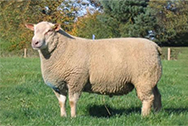
Charolais sheep
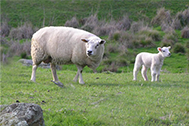
Texel sheep
Quality features
The label "Laine de France" guarantees the French origin and European processing of the wool. This label is controlled by farmers, traders and processors at the French Wool Association.
The wool we use has a certificate of origin with the corresponding analytical studies of chemical composition and physical parameters.
Quality testing for harmful substances: Despite modern instrumental analysis technology (gas chromatography, IR-spectroscopy) none of the investigated noxious substances are detectable.
Guarantee
All quality data are supported by the company's own internal inspections, as well as by independent third parties in external inspections. The "Eco-Umweltinstitut" stands for scientific objectivity and accuracy.
Ecology
The renewable raw material wool is obtained with live shearing. The gentle processing of our wool avoids the use of aggressive chemicals. However, ecological problems can also result from the often practiced, conventional treatment of animals and wool with chemicals: as a result, pesticides are released into the environment and into the wool in significant quantities!
Natural latex
Material
Natural rubber from vegetable milk juice.
General: The name rubber refers to the South American origin of the plant from the spurge family: CA-HU-CHU. Indian ketchua for weeping tree. Botanical name: Hevea Brasiliensis.
German name: Parakautschuk-Tree
Origin
Natural extraction from the milk (latex) of the rubber tree, which still grows in its original region of South America, but today is mainly found in South Asia, Indonesia, Vietnam, Malaysia, and Sri Lanka, ...
Chemical composition of rubber: Latex, a watery dispersion of natural polymers, contains 30-35% rubber components, 60-65% water, proteins, lipoids (fats), and carbohydrates with approx. 1% each. Mineral components (ash): approx. 0.5%.
The basic building blocks (monomers) of rubber are the isoprene units: 2-methyl-1,3-butadiene, (C5H8)n with approx. n= 3,000 units in the skeleton (polymer). Isoprene is the building block preferred by nature, both in the animal kingdom (e.g. cholesterol) and in the plant kingdom: here, the so-called isoprene-based terpenes characterize the composition of many beneficial essential oils.
Production
Gentle vulcanization of the milk for spatial cross-linking of the existing isoprene chains. Basically, the use of climate-damaging CFCs for foaming is avoided. This also applies to the omission of UV stabilizers. Several additional cleaning steps remove any remaining traces of substances from the production process.
Features
Biological: The antibacterial and anti-mite characteristics promise sensitive people relief and freedom from the typical symptoms of house dust allergy (nose and eye irritation).
Physical: Various degrees of firmness, point-elastic behavior and high flexibility, breathable, and vapor permeable (moisture regulating) due to micro-fine air chambers. As THE elastomer, rubber can be stretched up to eight times(!) of its length, but always returns to its original shape.
Chemical: No evaporation of volatile chemicals. No traces of nitrosamines, as it is often the case with synthetic latex, for example.
Medical: In addition to the material-specific, reduced risk of germs and mites, the health-promoting climatic characteristics of the pollutant-minimized - and thus health-promoting — natural material should be emphasized. The proven concept of rubber shells with specially shaped profiles (surface and channels) combines the high orthopedic demands and comfort with the natural material advantages in an ideal way.
Finally, the natural product is cleaned of proteins and the residues of attached vulcanizing agents in the course of its gentle processing.
Testing for harmful substances/Purity
Quality testing for harmful substances: Despite modern instrumental analysis technology (gas chromatography, IR-spectroscopy) none of the investigated noxious substances are detectable.
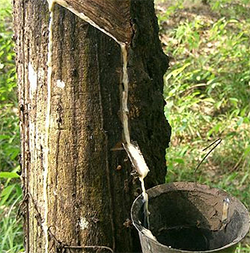
We purchase and process only certified raw material, which has been examined and verified by the ECO Institute for pollutants and purity.
Ecology
The use of the weeping tree has a long tradition. The milky juice can be harvested for decades without damaging the plant. In contrast to the synthetic production of rubber products from petroleum, the natural way proves to be gentle: minimal consumption of resources and minimal emissions during processing.
With the basic idea of sustainable management and the now recognized importance of the rainforest, uncontrolled clear-cutting to establish plantations in emerging developing countries is also a thing of the past.
By purchasing a natural product, the buyer makes a contribution to environmental protection and development aid.
Note: We only use the term natural latex mattress for a material with a natural rubber share of 100%. Unfortunately, there are many products on the market with a natural/synthetic mixture, which are sold as natural latex. There are also offers of 100% natural latex, but in which extenders (such as chalk) are added to facilitate production. You can recognize these by the fact that the upper and lower sides of the core are unequal: The upper side is closed and slightly wavy, the lower side has pen holes. Although this is natural latex, it becomes brittle due to the extenders.
Our natural latex is always 100% natural and of high density because only this way a futon-like elasticity is created and lasts extremely long.
Coconut Fiber
Material
Natural material of plant-based origin. Fruit fibers that are attached to the hard shell of the coconut.
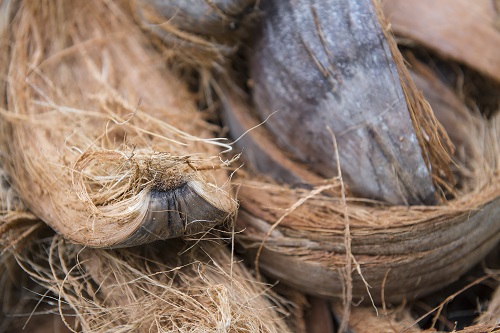
General information
The coconut palm with all its components is used by humans: the wood serves as a building material, the fruit as food, fermented, and burned palm juice as an alcoholic stimulant. In addition, coconut fats and oils are extracted from the plant for consumption or to produce soap and candles. As the only one of all fruit husk fibers, coconut fiber can also be spun.
Origin
As the only type in the family of feather palms, the coconut palm (Cocos Nucifera) grows in the entire tropical coastal area. Cultivation is traditionally practiced especially in India and Sri Lanka.
Chemical composition of coconut fiber:
The organic plant material contains the typical macromolecules that form fiber material. The spinnable raw material here is cellulose, which -- as in cotton, linen, and other plant species used for textiles -- builds up from the sugar blocks to form a polysaccharide in long chains. The chain length and the degree of cross-linking of the building blocks is also a specific feature of the respective plant - with direct effects on the physical characteristics of the fibers (hardness, spinnability, etc.)
Production
The coconut fibers are extracted from the bast layer of the coconut. Picking before ripening produces fibers with a lower degree of lignification. The fibers can be removed by so-called "roasting" in brackish water over several weeks. They are then beaten, mashed, and milled to make the fibers more supple. Finally, the 15-35cm long coconut fibers are washed and dried.
Use
Due to its resistance to water, the fiber has been used to make ship ropes for as long as anyone can remember. A variety of household items such as brooms, brushes, etc., but also mats and carpets are made from coconut fiber. The resulting yarn quality of the fibers (color, purity, stretching degree, thickness, etc.) depends on the degree of ripeness of the nuts and the roasting and spinning processes used.
As a cushioning material, it enjoys great popularity as the so-called 'vegetable horsehair', the vegetable alternative.
Features
Biological: coconut fibers have a high resistance to microbial rotting processes (and to humidity): because they are fat-free, they do not provide a suitable breeding ground for microorganisms.
Physical: fibers with a low specific weight are very flexible. Due to their tubular structure, they have a heat-insulating and sound-absorbing effect and are also extremely durable. Furthermore, water can be absorbed or released by the hygroscopic fibers - depending on the degree of air humidity and room humidity. This gives the material a moisture-regulating function.
Chemical: The fiber is highly resistant to chemicals (seawater!).
Medical: The material's properties have a positive effect on people who are particularly sensitive to chemicals and environmental influences. Allergy sufferers benefit from the low germ density. When coconut fibers are used in mattresses, the moisture regulation creates a pleasantly cooling effect.
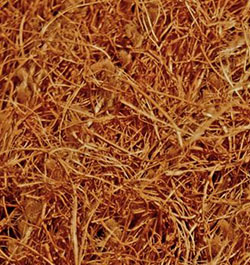
Quality feaures
The coconut fibers we use are guaranteed to be free of harmful substances according to analytical tests. (Note: nothing can be 100% free of pollutants - depending on the definition). While coconut fibers are sometimes (senselessly) loaded with e.g. toxic lindane or the carcinogenic pentachlorophenol, DDT, formaldehyde, etc., we can exclude this with our coconut products.
Quality testing for harmful substances and their possible release: Despite modern instrumental analysis technology (gas chromatography, IR-spectroscopy) none of the investigated noxious substances are detectable.
Ecology
The use of the coconut palm is as far as possible in accordance with the requirements of modern environmental protection. The modest tree does not require intensive treatment and is harvested as it has been for thousands of years. Monocultures are usually not created for this purpose. The processing of renewable raw material is also carried out without harmful effects on the environment. In new, innovative projects, coconut waste is also converted into a valuable organic fertilizer through composting. Here, assistance is provided by fungal cultures that break down the highly wood-containing material, which is difficult to compost without inoculation. The rural and labor-intensive "coconut industry" thus makes a valuable contribution to local and global environmental protection and makes a stabilizing social contribution in the coconut-growing countries.
Horsehair
Material
Natural material of animal origin: horsehair from tail and mane.
General information
Horsehair was already being used at the beginning of the 19th century as a cushioning material, which was characterized among other things, by its springiness. The use of this natural material has decreased considerably in the last decades due to the use of springs and synthetic foams. As an environmentally friendly material, horsehair is now being rediscovered as a raw material with excellent attributes, but without chemical side effects.
Origin
For our mattresses, we use selected good-quality horsehair (mixed hair, tail/mane) that comes mainly from Mongolian horse breeds, whose hair is characterized by length (15 cm), density, and fineness.
Chemical composition
of horsehair:The hair (also: wool, nails, horn, feathers) is a protein and is composed of amino acids. The group of these protein structures is called the chemical term keratins. Despite its very strong structural similarity to wool, horsehair has higher strength and resistance due to the geometry of the macromolecules.
Production
After "cutting the hair", the natural raw material is cleaned with curd soap. No other chemical agents are used which could affect the natural self-cleaning power of the hair. After cleaning, the protein fibers are prepared for spinning and are finally processed into mats.
Use
In addition to the above-mentioned use as a cushioning material, horsehair is also used as a basic material for yarns, twisted yarns, and interlining fabrics. Pure horsehair fabrics are also required for the production of fine hair sieves. Horsehair is mainly used today as a component of high-quality mattresses, good brooms, brushes, and textiles.
Features
Biological: Due to their chemical structure, keratins offer hardly any weak points for biological attacks of microorganisms. Wool and hair can survive unchanged for long periods of time.
Physically: The natural crimping of horsehair provides mattresses with a high degree of filling and elasticity. In addition to its elastic properties, the
natural material also has extraordinarily good moisture and heat-regulating functions. A further advantage is its self-cleaning power: odorous substances are absorbed into the macromolecules and thus "deodorized".
Chemical:Like wool, horsehair is quite chemically inert and resistant to acids. In comparison to wool, which is already durable, horsehair is even more durable under normal environmental conditions.
Medical: The above physical properties can be used medically in the same way as wool. The warming function can have a positive effect on circulation and joints.
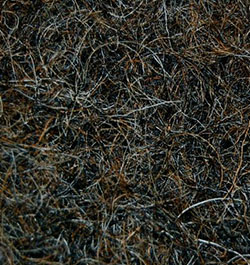
Guarantee
All quality data are supported by the company's own internal inspections as well as by independent third parties in external inspections. The "Eco-Umweltinstitut" stands for scientific objectivity and accuracy.
Ecology
The use of this natural material fulfills all the requirements for environmental protection. With the purchase of this natural product, the buyer, therefore, makes a contribution to environmental protection and sustainable economic activity - and avoids synthetic products with their often negative environmental characteristics.
Caution! Note for sophisticated customers: There is also a synthetically produced monofilament product on the market with finenesses like natural horsehair: chemical horsehair. Furthermore, horsehair-like fibers of vegetable origin are obtained from the dwarf palm and tillandsia
To the glossary: Horsehair
Back to top
BioNeem / Milbopax
Handout BioNeem (Today: Milbopax)
Since the wonderful invention of Prof. Dr. Remboldt (Max-Planck-Institute), the house dust allergy in the mattress area (as well as upholstery, carpets, .....) has become a much smaller problem. At least affected people no longer need to go without natural mattresses and can better use the time for washing mattress covers.
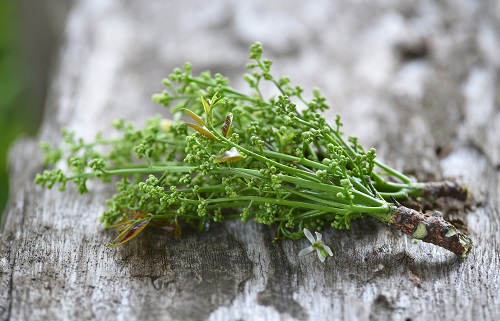
Bio-Neem is one of the products that are available under different names, in the pharmacy under 'Milbopax' (available very inexpensively on the Internet) and is based on the active ingredient formula TN-MP-100. This product consists of ingredients, such as azadirachtin, which has been extracted from the oil of the seed fruit of the neem tree and is highly active against mites (arachnids). Long-term tests in the 90s (the product has been on the market since 1998.) have shown that the effect of the product on a new mattress lasts for three years. We recommend house dust allergy sufferers to treat the mattress for the first time after two years and then annually, whereby one spray bottle (100ml) is sufficient for a mattress measuring 100 x 200. The mattress is sprayed evenly from the outside as well as from the inside (if possible); the slight odor caused by the solvent disappears quickly.
The effect of this natural substance is very good!
In order to make the allergy-causing effect and the effect of the means clear, some information around the mite: approx. 30,000 different arachnids exist. Some dozen of them are listed as local mites. The insects, which are on average 0.15 to 0.5 mm in size and therefore hardly visible, are present everywhere (!) and are therefore unavoidable. They actually perform a useful function, namely the removal of dirt on the smallest scale. Regarding humans and their environment, this has an effect, the extermination of skin scales, fat residues, etc., i.e. mainly human protein. So what the mite excretes is also a form of protein, which leads to an allergic false reaction in the inclined body of a house dust allergy sufferer.
The mites, which essentially reproduce in spring (natural rhythm) develop when there is a good nutritional basis, such as a bed that provides massive populations of five and six-digit size in the course of a few years. The excrements produced then form a large order of magnitude, which gives the house dust allergy sufferer a hard time. The microbially small particles stick to the house dust swirling around, which we breathe in with the air and by this give the allergy its name.
If now the mattress (the cushion, the carpet) is wetted with Bio-Neem (TN MP100), the mites take up the product with the food intake and become incapable of propagation.
On the other hand, it acutely disrupts their basic supply of bitter substances (chitin) and leads to death.
Since mites are always and everywhere present and therefore it cannot be avoided that they also reach a bedroom, no matter how well cared for, the mite can only be treated in this way. The efficiency of the product is higher than that of 'washing', because the mites, i.e. the causative agents, are reached.
We offer every mattress already with Bio-Neem equipment, but we recommend the cheaper self-treatment of the new mattress. Older mattresses, up to 3 years, can also be treated. However, in this case, we recommend using twice the amount of the product.
Further information from the manufacturer and about the development and tests can be found here as a PDF:
TN-MP-100/Development
TN-MP-100/Manufacturer Info
and the ...
Factsheet Neem
MaterialNeem oil. Natural material of plant-based origin, oil from the seeds of the neem tree.
General information
The Neem tree (also: Niem- or Nim tree) is a relative of the mahogany tree and belongs to the Meliaceae family. The up to 20m high tree is modest and gets over 200 years old. For thousands of years, the Neem tree has been used in its entirety (fruits, seeds, leaves, roots, oils) in Ayurvedic medicine.
Origin
The Latin name Azadirachta indica reveals not only the active ingredients (azadirachtin) inherent in this tree but also its country of origin, India. In former times, the distribution area was limited to north-eastern India, Burma, and Bangladesh. As a very frugal plant, the tree was planted in Central America, Africa, Hawaii, and the Philippines as a wind shelter, provider of shade, and above all, against soil erosion.Chemical composition of neem oil: The ingredients and their concentrations of the natural oil, extracted from seeds, are subject to the fluctuations typically found in natural products. The traded Neem oils consist mainly of various vegetable oils. As an important chemical component, the insect repellent substance azadirachtin (and further, different derivates of this substance group) occurs. The group of limonoids contained in the oil is characterized by their strong fungicidal effects. The phenolic compounds found in the oil have anti-inflammatory effects on the one hand and strengthen the immune system on the other. The ingredient salannin acts as a strong repellent on insects.
Production
After ten years, a fruit yield of about 50kg can be expected from the tree. The seeds contain up to 40% neem oil. First, the seeds of the olive-like fruit must be dried to prevent rotting. Afterward, the oil is traditionally extracted by pressing the seeds but increasingly also by extraction with solvents.
Use
For thousands of years, the tree has been used daily by a large part of the Indian population. For example, the branches are used as a natural toothbrush against gum and tooth disease - in Germany Neem toothpaste and Neem soaps have been available for several years. The plant is also used as fuel and cattle feed, but its human medicine and plant protection effects are mainly appreciated. The list of these applications and recipes is endless: it is not without reason that the Neem plant is considered by the Indians to be the tree for everything.
Use
Biological: Neem oil acts as natural, biological protection against dust mites and other harmful insects such as moths. Neem extracts can have a sterilizing, growth- and skin-inhibiting effect on insects, but also a scavenging and feeding deterrent effect. The excellent effect on mites is particularly noteworthy: textiles prepared with Neem extracts remain free of mites for a very long time.
Physical: oily liquid
Chemical: Neem oil is non-toxic and therefore toxicologically safe for humans and mammals, even in high doses.
Medical: Due to its biological effects, Neem oil is an excellent hygienic substance in preventive mattress impregnation, both for the prevention of allergies and for reducing the symptoms of existing house dust allergies.
The natural preparation is used as medicine in a multiplicity of applications, for example, for blood purification, against sleep disturbances (!), rheumatism, stomach pain, nausea, and much else. In addition, the fungicidal (e.g. against Candida) and antibacterial (e.g. against pus exciter) characteristics of neem extracts are well-known. But that is not all: Neem is also said to have immune-boosting and anti-inflammatory effects as well as prophylactic, antiviral (e.g. herpes) characteristics.
In the distribution area of the neem tree, its components are also used to reduce pain and fever.
Quality features
The neem oil we use has a certificate of origin with the corresponding analytical tests for ingredients and the absence of pollutants.
The effectiveness and long-term protection of the Neem-Protect treatment of textile materials have been confirmed by the Institute for Environmental Diseases (Bad Ems). The good compatibility of the treated natural latex mattresses for allergy sufferers was also confirmed.
Safety
All quality data are supported by the company's own internal inspections as well as by independent third parties in external inspections. "ECO-Umweltinstitut“ stands for scientific objectivity and accuracy.
Ecology
The neem tree is a renewable resource. Its cultivation alone contributes to soil improvement and prevents erosion. With the comprehensive naturopathic and medical benefit profile of its components, the plant contains an entire pharmacy.
In addition to the holistic cycle management and the neutral CO2-balance of the tree, the use of the gentle natural chemicals also avoids the usage of highly poisonous insecticides and can possibly replace synthetic drugs when used medically.
Caution: There is now an unmanageably high number of Neem products. In contrast to many other mixtures, which vary greatly in their composition, the preparations with the active ingredient formula TN-MP-100 are always standardized: this guarantees a reliable effective formula against the otherwise very resistant house dust mites.



